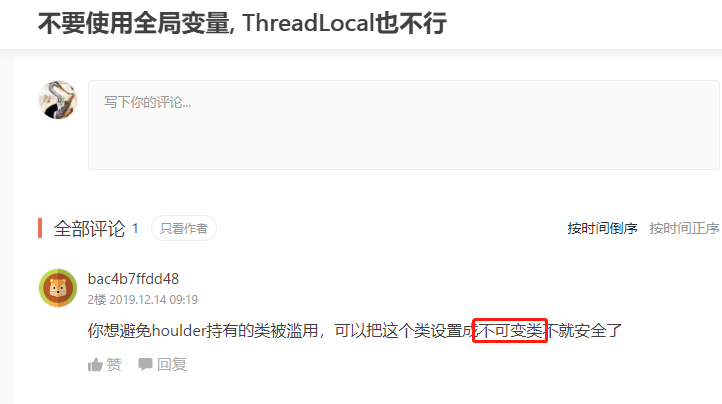如何写一个不可变类
写在前面
开局是这样的, 在看到springmvc Controller默认是单例的时候, 会引发成员变量竞争访问的问题, 于是有了解决方案123, 其中有一个方案是在Controller中使用threadLocal变量, 如何使用threadLocal变量? 查资料的过程中有一篇这样的文章:不要使用全局变量, ThreadLocal也不行 于是有了这篇东拼西凑的博文.看到最后发现貌似在Controller上添加@Scope("prototype")注解是最简单粗暴的方案.

什么是不可变类
不可变类的意思是创建该类的实例后,该实例的属性是不可改变的;所以不可变类并不是指该类是被final修饰的,而是指该类的属性是被final修饰的。
自定义不可变类遵守如下原则:
1> 使用private和final修饰符来修饰该类的属性。
2> 提供带参数的构造器,用于根据传入的参数来初始化属性。
3> 仅为该类属性提供getter方法,不要提供setter方法。并且使用copy-on-write原则,创建私有的copy
4> 如果有必要,重写hashCode和equals方法,同时应保证两个用equals方法判断为相等的对象,其hashCode也应相等
5> 通常构造对象时,成员变量使用深度拷贝来初始化,而不是直接赋值,这是一种防御措施,因为你无法确定输入变量不被其他人修改
Ps:
List<String> immutableList = List.of(“不可变的list”); immutableList.add(“allen”);会抛异常
最近看到一个不错的
https://blog.csdn.net/Ithinkthereforiam/article/details/60781771
https://www.cnblogs.com/Shevo/p/8414649.html
https://www.jianshu.com/p/07955d0e4a1c
不可变类有什么优点
- 方便构造、测试和使用
- 线程安全,没有同步问题
- 不需要拷贝构造方法
- 不需要实现Clone方法
- 可以缓存类的返回值,允许hashCode使用惰性初始化方式
- 不需要防御式复制
- 适合用作Map的key和Set的元素(因为集合里这些对象的状态不能改变)
- 类一旦构造完成就是不变式,不需要再次检查
- 总是“failure atomicity”(原子性失败):如果一个不可变对象抛出异常,它从不会保留一个烦人的或者不确定的状态
- 易于构造,测试和使用
- 天然线程安全,没有同步问题
- 不需要实现clone方法
- 引用不可变类的实例时,不需要考虑实例的值发生变化的情况
如何创建不可变类
要创建不可变类,要实现下面几个步骤:
- 将类声明为final,所以它不能被继承
- 将所有的成员声明为私有的,这样就不允许直接访问这些成员
- 对变量不要提供setter方法
- 将所有可变的成员声明为final,这样只能对它们赋值一次
- 通过构造器初始化所有成员,进行深拷贝(deep copy)
- 在getter方法中,不要直接返回对象本身,而是克隆对象,并返回对象的拷贝
为了理解第5和第6条,我将使用FinalClassExample来阐明。
FinalClassExample.java
package com.journaldev.java; import java.util.HashMap; import java.util.Iterator; public final class FinalClassExample { private final int id; private final String name; private final HashMap testMap; public int getId() { return id; } public String getName() { return name; } /** * 可变对象的访问方法 */ public HashMap getTestMap() { //return testMap; return (HashMap) testMap.clone(); } /** * 实现深拷贝(deep copy)的构造器 * @param i * @param n * @param hm */ public FinalClassExample(int i, String n, HashMap hm){ System.out.println("Performing Deep Copy for Object initialization"); this.id=i; this.name=n; HashMap tempMap=new HashMap(); String key; Iterator it = hm.keySet().iterator(); while(it.hasNext()){ key=it.next(); tempMap.put(key, hm.get(key)); } this.testMap=tempMap; } /** * 实现浅拷贝(shallow copy)的构造器 * @param i * @param n * @param hm */ /** public FinalClassExample(int i, String n, HashMap hm){ System.out.println("Performing Shallow Copy for Object initialization"); this.id=i; this.name=n; this.testMap=hm; } */ /** * 测试浅拷贝的结果 * 为了创建不可变类,要使用深拷贝 * @param args */ public static void main(String[] args) { HashMap h1 = new HashMap(); h1.put("1", "first"); h1.put("2", "second"); String s = "original"; int i=10; FinalClassExample ce = new FinalClassExample(i,s,h1); //Lets see whether its copy by field or reference System.out.println(s==ce.getName()); System.out.println(h1 == ce.getTestMap()); //print the ce values System.out.println("ce id:"+ce.getId()); System.out.println("ce name:"+ce.getName()); System.out.println("ce testMap:"+ce.getTestMap()); //change the local variable values i=20; s="modified"; h1.put("3", "third"); //print the values again System.out.println("ce id after local variable change:"+ce.getId()); System.out.println("ce name after local variable change:"+ce.getName()); System.out.println("ce testMap after local variable change:"+ce.getTestMap()); HashMap hmTest = ce.getTestMap(); hmTest.put("4", "new"); System.out.println("ce testMap after changing variable from accessor methods:"+ce.getTestMap()); } }
输出
Performing Deep Copy for Object initialization true false ce id:10 ce name:original ce testMap:{2=second, 1=first} ce id after local variable change:10 ce name after local variable change:original ce testMap after local variable change:{2=second, 1=first} ce testMap after changing variable from accessor methods:{2=second, 1=first}
现在我们注释掉深拷贝的构造器,取消对浅拷贝构造器的注释。也对getTestMap()方法中的返回语句取消注释,返回实际的对象引用。然后再一次执行代码。
Performing Shallow Copy for Object initialization true true ce id:10 ce name:original ce testMap:{2=second, 1=first} ce id after local variable change:10 ce name after local variable change:original ce testMap after local variable change:{3=third, 2=second, 1=first} ce testMap after changing variable from accessor methods:{3=third, 2=second, 1=first, 4=new}
从输出可以看出,HashMap的值被更改了,因为构造器实现的是浅拷贝,而且在getter方法中返回的是原本对象的引用。
感谢
-
https://blog.csdn.net/pql925/article/details/69822662
-
https://www.jianshu.com/p/2080b524fb3a
-
Java中的不可变类
-
什么叫不可变类
作者:习惯沉淀
如果文中有误或对本文有不同的见解,欢迎在评论区留言。
如果觉得文章对你有帮助,请点击文章右下角【推荐】一下。您的鼓励是博主的最大动力!
扫码关注一线码农的学习见闻与思考。
回复"大数据","微服务","架构师","面试总结",获取更多学习资源!


 浙公网安备 33010602011771号
浙公网安备 33010602011771号